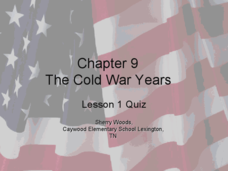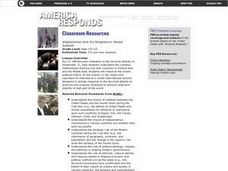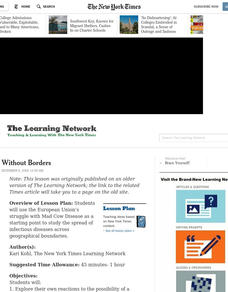Curated OER
The Progressive Movement
While the Progressives never formed a political party they did develop an ideology. Provide viewers with an interesting, yet challenging presentation on the Progressive Movement that introduces key individuals and highlights key events...
PB Works
Film Viewing Guide for the movie “Glory” (1998)
Check out this simple, ready-to-use worksheet that your young historians can complete as they watch the motion picture Glory. It begins with a very brief list of characters to track, followed by seven short-answer questions to be...
K12 Reader
Character Analysis in the Red Badge of Courage
As part of a comprehension exercise, readers analyze the character of Henry Fielding and consider how his romantic view of himself, and of war, changes.
University of Wisconsin
Why Did the Triangle Fire Occur?
An investigation of the 1911 New York City Triangle Shirtwaist Factory fire leads class members to examine primary and secondary source materials related to the event and apply what they learn about the working conditions at the time to...
Core Knowledge Foundation
Isn’t It Exciting? (The American Industrial Revolution and Urbanization)
America was built on the ingenuity, work ethic, and foresight of our ancestors. Sixth graders learn about the complex Gilded Age in American history, including the prominent inventors and captains of industry, and how they all connect...
K12 Reader
Elegy for Lincoln: Walt Whitman’s Poem
Walt Whitman's "O Captain! My Captain!" is one of the most famous and emotional tributes to Abraham Lincoln. Guide readers through the evocative elegy with a reading comprehension instructional activity, complete with the poem's text and...
PBS
Evaluating Conflicting Evidence: Sultana
What sunk the Sultana? Scholars become investigators to uncover the facts behind the 1865 sinking just after the end of the Civil War. Through group work, videos, and primary documents, they research and analyze why 1,800 men died....
PBS
Civil War: Blacks on the Battlefield
Imagine a war being fought to free slaves, with slaves on the front line. Scholars use primary documents, videos, and research in the second installment of a three-part series to guide their analysis of the first African-Americans on the...
Curated OER
Chapter 9: The Cold War Years
Students take a quiz on The Cold War Years of the 1950's and 1960's. This 20-slide presentation covers a variety of world-wide and domestic topics, and includes slides which give hints as to what the correct answers are.
Curated OER
Prowling Polar Bear
Students show their support for preserving threatened and endangered species by creating and sculpting a replica of a polar bear. They discuss the agreement that the United States, Canada, Denmark, Norway and the Soviet Union signed in...
Curated OER
Centennial: Utah We Love Thee
Fourth graders discuss how music can inspire emotion and are introduced to Utah's state song, "Utah, We Love Thee". They discuss the song and then compare and contrast other songs about Utah. They create original lyrics about Utah.
Curated OER
A Geopoem About Alaska
Sixth graders conduct Internet research on the physical and human characteristics of Alaska. They compose and write geopoems about the state of Alaska, using a template.
Curated OER
Afghanistan and Its Neighbors: Model Summit
Students examine the relationship between the United States and the Soviet Union during the Cold War. They discover the role of religion and cultural identity in the war in Afghanistan. They explore the arguments for and and against...
Curated OER
Nation Building
Ninth graders examine the role of the United States in nation building. For this World History activity, 9th graders evaluate the role of the United States in building nations in other parts of the world.
Curated OER
What is a Democracy?
Students identify what makes a country democratic and compare United States and Indian political party symbols. They create their own political party and party symbol. They create a campaign speech, participate in the voting process...
Curated OER
Lincoln Theme--Gettysburg
Fifth graders explore the significance of the Gettysburg Address. In this United States history lesson, 5th graders listen to a Gettysburg Address recording and look at photos of the battlefield. Students discuss their observations and...
Curated OER
Diseases Without Borders
Learners use the European Union's struggle with Mad Cow Disease as a starting point to study the spread of infectious diseases across geographical boundaries.
Curated OER
History: Robert Gould Shaw and the 54th Massachusetts
Students read a letter by Shaw to his wife after the Union raid at Darien, Georgia; then will draw conclusions about it. Students debate about the Emancipation Proclamation as well as the possibility of allowing blacks to serve in the...
Curated OER
How Did the Other Half Live?
Students study the conditions under which immigrants lived. They determine what it means to make it in America. They observe the connection between immigration and unionization and how immigration changed the City of New York. They...
Curated OER
Lesson III: Crisis, Pearl Harbor, Internment
The third in a series of lessons introduced by “A Fence Away From Freedom,” uses the Smithsonian website, “A More Perfect Union: Japanese Americans and the U.S. Constitution” and focuses on the section of the presentation devoted to the...
Curated OER
Iranian Uranium?
Students explore how Iran's uranium enrichment-related activities has caused a rift between Russia, the United States, and Europe. They stage a mock summitt to discuss Iran's nuclear program.
Ed Change
Equity and Diversity Awareness Quiz
Here is a multiple choice assessment in which students respond to 15 questions relating to social justice, equity, and diversity issues in the United States.
Curated OER
Life and Death in the Camps
Students state the difference between death camps and concentration camps used during the Holocaust. Using primary source documents, they summarize what life in the camp was like. They describe the final solution used by the Nazis.
Curated OER
Tall Tales and Urban Legends
Students identify and interpret what tall tales, urban legends, and cyberlore are and to find them in their own lives. They practice telling and listening to these types of tales and explore why people tell them. Students also identify...

























